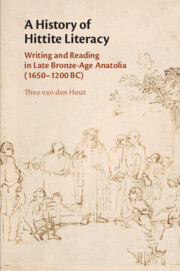Book contents
- A History of Hittite Literacy
- A History of Hittite Literacy
- Copyright page
- Dedication
- Contents
- Figures
- Tables
- Preface and Acknowledgments
- Map
- Timeline and Hittite Kings
- Sigla and Abbreviations
- Chapter 1 Introduction
- Chapter 2 Writing and Literacy among the Anatolians in the Old Assyrian Period
- Chapter 3 From Kanesh to Hattusa
- Chapter 4 First Writing in Hattusa
- Chapter 5 Literacy and Literature in the Old Kingdom until 1500 BC
- Chapter 6 The Emergence of Writing in Hittite
- Chapter 7 A Second Script
- Chapter 8 The New Kingdom Cuneiform Corpus
- Chapter 9 The New Kingdom Hieroglyphic Corpus
- Chapter 10 The Wooden Writing Boards
- Chapter 11 The Seal Impressions of the Westbau and Building D, and the Wooden Tablets
- Chapter 12 In the Hittite Chancellery and Tablet Collections
- Chapter 13 Scribes and Scholars
- Chapter 14 Excursus
- Chapter 15 The End and Looking Back
- Bibliography
- Index Locorum
- General Index
Chapter 10 - The Wooden Writing Boards
Published online by Cambridge University Press: 18 December 2020
- A History of Hittite Literacy
- A History of Hittite Literacy
- Copyright page
- Dedication
- Contents
- Figures
- Tables
- Preface and Acknowledgments
- Map
- Timeline and Hittite Kings
- Sigla and Abbreviations
- Chapter 1 Introduction
- Chapter 2 Writing and Literacy among the Anatolians in the Old Assyrian Period
- Chapter 3 From Kanesh to Hattusa
- Chapter 4 First Writing in Hattusa
- Chapter 5 Literacy and Literature in the Old Kingdom until 1500 BC
- Chapter 6 The Emergence of Writing in Hittite
- Chapter 7 A Second Script
- Chapter 8 The New Kingdom Cuneiform Corpus
- Chapter 9 The New Kingdom Hieroglyphic Corpus
- Chapter 10 The Wooden Writing Boards
- Chapter 11 The Seal Impressions of the Westbau and Building D, and the Wooden Tablets
- Chapter 12 In the Hittite Chancellery and Tablet Collections
- Chapter 13 Scribes and Scholars
- Chapter 14 Excursus
- Chapter 15 The End and Looking Back
- Bibliography
- Index Locorum
- General Index
Summary
An overview of all possible terms denoting wooden tablets indicates that few can be regarded as positive evidence. As a result, it is argued that wooden tablets played a secondary and even modest role in scribal communication. There is also no real evidence for the theory that they were inscribed in hieroglyphs instead of cuneiform. The strong Luwian character of the terms discussed reinforces the picture of a Luwian speaking population in the chancellery. Other issues discussed here are the objects often identified as styli and assumed to be used for writing hieroglyphs, the cursivization of the hieroglyphic script, and Hittite terms for writing.
Keywords
- Type
- Chapter
- Information
- A History of Hittite LiteracyWriting and Reading in Late Bronze-Age Anatolia (1650–1200 BC), pp. 184 - 217Publisher: Cambridge University PressPrint publication year: 2021

